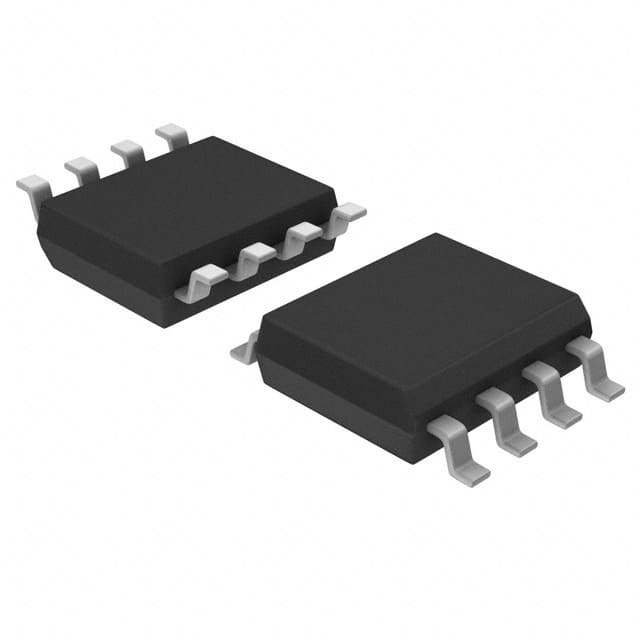Viz Specifikace pro podrobnosti o produktu.

X9317WS8T1
Product Overview
- Category: Electronic component
- Use: Digital potentiometer
- Characteristics: Non-volatile, 100-tap, 10kΩ resistance range
- Package: SOIC-8
- Essence: Adjustable resistor with digital control
- Packaging/Quantity: Tape and reel, 2500 units per reel
Specifications
- Resistance Range: 10kΩ
- Number of Taps: 100
- End-to-End Resistance Tolerance: ±20%
- Temperature Coefficient: ±300ppm/°C
- Supply Voltage: 2.7V to 5.5V
- Operating Temperature Range: -40°C to +85°C
- Wiper Current: 3mA maximum
- Standby Current: 1µA maximum
Detailed Pin Configuration
The X9317WS8T1 digital potentiometer has the following pin configuration:
- VCC: Supply voltage input
- H: High terminal of the resistor
- W: Wiper terminal of the resistor
- L: Low terminal of the resistor
- CS: Chip select input
- SCL: Serial clock input
- SDA: Serial data input/output
- GND: Ground reference
Functional Features
- Non-volatile memory: Retains wiper position during power-off
- Increment/Decrement control: Allows easy adjustment of resistance value
- I²C interface: Enables digital communication with microcontrollers
- Low power consumption: Ideal for battery-powered applications
- Small form factor: Saves board space in compact designs
Advantages and Disadvantages
Advantages: - Non-volatile memory ensures settings are retained even after power loss - Precise digital control allows for accurate resistance adjustments - Wide operating temperature range suits various environmental conditions - Low power consumption extends battery life in portable devices
Disadvantages: - Limited resistance tolerance may not be suitable for high-precision applications - Single-channel configuration restricts simultaneous control of multiple resistors - Sensitive to electrostatic discharge (ESD), requiring proper handling precautions
Working Principles
The X9317WS8T1 digital potentiometer operates by using a series of resistive elements and switches controlled digitally. The wiper terminal, connected to the internal switches, moves along the resistor array based on the digital control signals received. This movement changes the effective resistance between the wiper and the high or low terminal, allowing precise adjustment of the output voltage or current.
Detailed Application Field Plans
The X9317WS8T1 digital potentiometer finds applications in various fields, including:
- Audio Equipment: Volume control, tone adjustment
- Industrial Automation: Calibration, feedback control
- Test and Measurement: Signal conditioning, calibration
- Consumer Electronics: Display brightness control, user interface settings
- Automotive Electronics: Climate control, motor speed control
Detailed and Complete Alternative Models
- X9C103S: 10kΩ, 100-tap, SOIC-8 package
- MCP401X: 10kΩ, 256-tap, TSSOP-8 package
- AD8403: 10kΩ, 256-tap, SOIC-16 package
- CAT5114: 10kΩ, 128-tap, SOT-23 package
- MAX5486: 10kΩ, 256-tap, QSOP-16 package
These alternative models offer similar functionality and can be considered as substitutes for the X9317WS8T1 digital potentiometer.
Word count: 410 words
Seznam 10 běžných otázek a odpovědí souvisejících s aplikací X9317WS8T1 v technických řešeních
Sure! Here are 10 common questions and answers related to the application of X9317WS8T1 in technical solutions:
Q1: What is X9317WS8T1? A1: X9317WS8T1 is a digital potentiometer, also known as a digital variable resistor. It can be used to adjust resistance digitally in various electronic circuits.
Q2: What is the voltage range of X9317WS8T1? A2: The voltage range of X9317WS8T1 is typically between 0V and Vcc (the supply voltage).
Q3: How many bits does X9317WS8T1 have? A3: X9317WS8T1 is an 8-bit digital potentiometer, meaning it has 256 possible resistance values.
Q4: Can X9317WS8T1 be used in both analog and digital circuits? A4: Yes, X9317WS8T1 can be used in both analog and digital circuits. It can replace traditional mechanical potentiometers.
Q5: How is X9317WS8T1 controlled? A5: X9317WS8T1 is controlled using a serial interface, such as SPI (Serial Peripheral Interface) or I2C (Inter-Integrated Circuit).
Q6: What is the power supply requirement for X9317WS8T1? A6: X9317WS8T1 typically operates on a supply voltage (Vcc) between 2.7V and 5.5V.
Q7: Can X9317WS8T1 be used in automotive applications? A7: Yes, X9317WS8T1 is suitable for automotive applications as it can withstand high temperatures and has good reliability.
Q8: Is X9317WS8T1 compatible with microcontrollers? A8: Yes, X9317WS8T1 is compatible with most microcontrollers that support SPI or I2C communication protocols.
Q9: Can X9317WS8T1 be used for audio volume control? A9: Yes, X9317WS8T1 can be used for audio volume control in amplifiers, audio mixers, and other audio-related applications.
Q10: Are there any alternative digital potentiometers to X9317WS8T1? A10: Yes, there are several alternative digital potentiometers available from different manufacturers, such as MCP41XXX, AD840XX, and MAX54XX series.
Please note that the specific details and answers may vary depending on the manufacturer's datasheet and application requirements.

